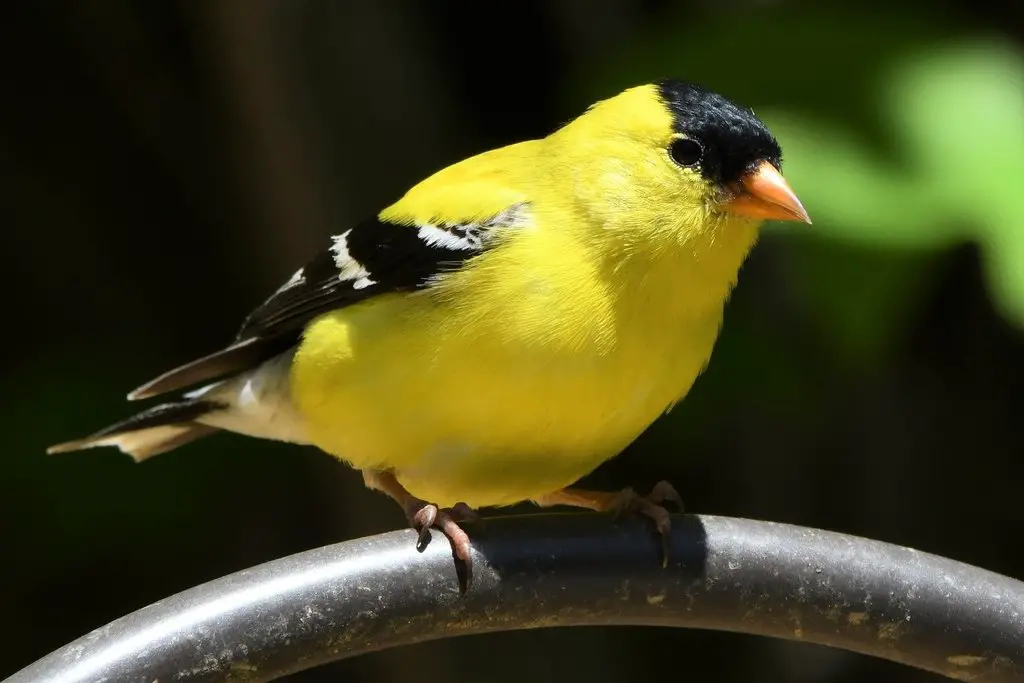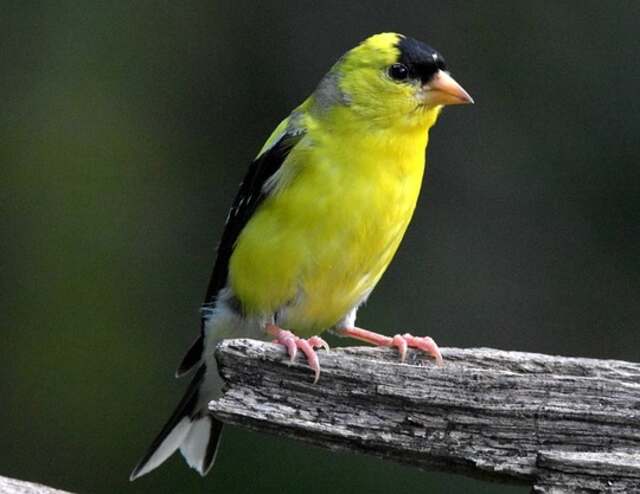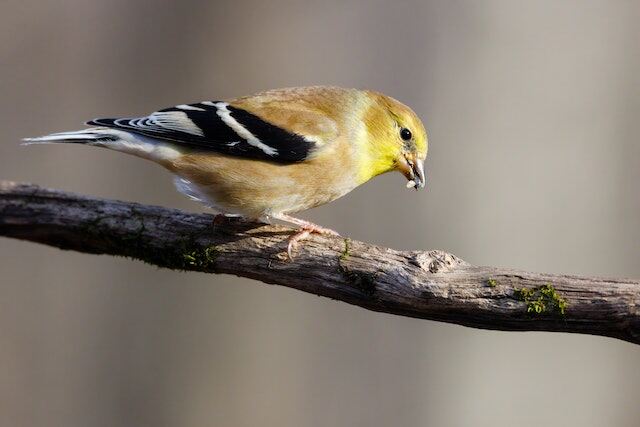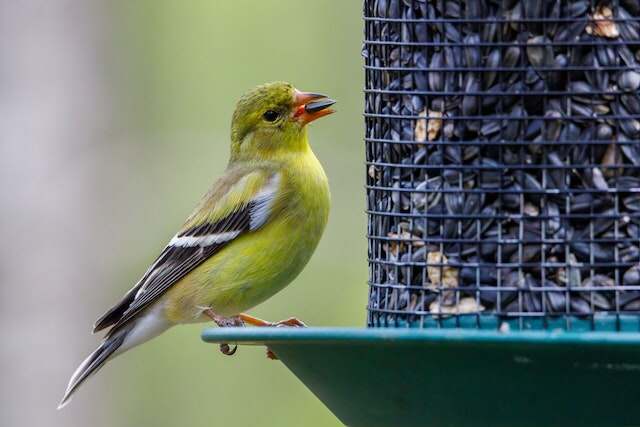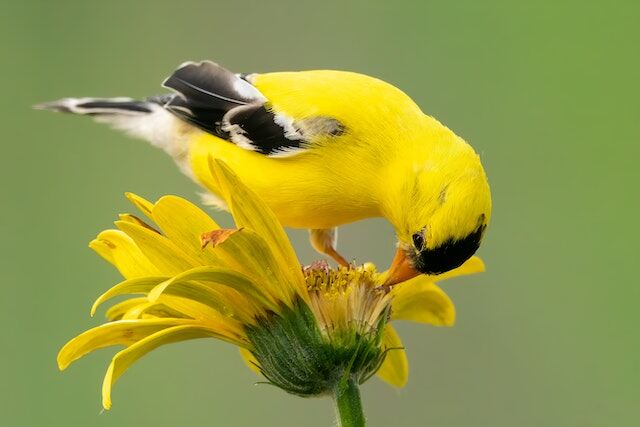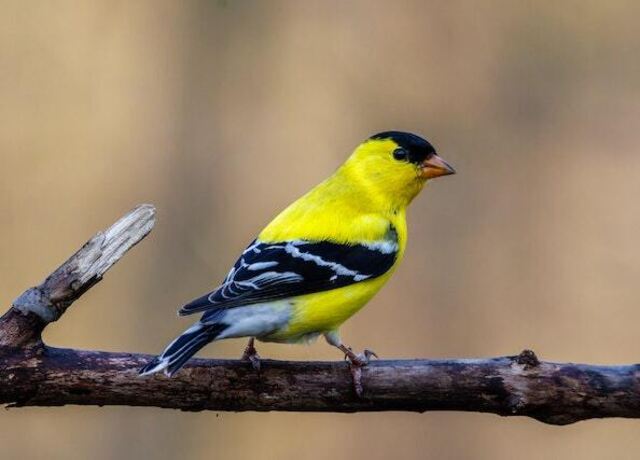The American Goldfinch, with its vibrant yellow feathers and cheerful song, is a favorite among bird enthusiasts. This small yet striking bird, often seen flitting through meadows and gardens, holds many intriguing secrets.
In this article, we’ll uncover fascinating facts about the American Goldfinch, from its unique feeding habits to its remarkable migratory patterns. Whether you’re a seasoned birdwatcher or simply curious, these insights will deepen your appreciation for this delightful avian species.
Table of Contents
- 1 Key Takeaways
- 2 American Goldfinch Interesting Facts
- 3 Key Identification Traits
- 4 Vibrant Yellow Plumage – A Distinctive Trait
- 5 Year-Round Residents and Migratory Habits
- 6 Seed-Eating Birds with a Thistle Seed Diet
- 7 Acrobatic Flight – Skills in the Air
- 8 Distinct Summer and Winter Plumage – A Seasonal Transformation
- 9 Behavior Traits and Social Interactions
- 10 Diet Beyond Seeds – Exploring Other Preferences
- 11 Habitat and Range – Where to Spot American Goldfinches
- 12 Conservation Status and Threats
- 13 Wrapping Up American Goldfinch Interesting Facts
- 14 FAQs: American Goldfinch Interesting Facts
- 14.1 What is the American Goldfinch?
- 14.2 What is the significance of the American Goldfinch’s vibrant yellow plumage?
- 14.3 Are American Goldfinches year-round residents or migratory birds?
- 14.4 What do American Goldfinches eat?
- 14.5 Why are American Goldfinches known for their acrobatic flight?
- 14.6 Is the American Goldfinch the state bird of any U.S. states?
- 14.7 Does the American Goldfinch undergo seasonal plumage variations?
- 14.8 What are some behavior traits and social interactions observed in American Goldfinches?
- 14.9 Where can American Goldfinches be found?
- 14.10 What is the conservation status of the American Goldfinch?
- 14.11 What are the key takeaways about the American Goldfinch?
- 15 Author
Key Takeaways
- The American Goldfinch is a small bird with distinctive yellow plumage and black wings with white markings.
- It is a seed-eating bird with a preference for a thistle seed diet.
- The species is a year-round resident in certain regions and migrates in others.
- They are incredibly acrobatic in flight and have a unique seasonal plumage transformation.
- The American Goldfinch is the state bird of Iowa, New Jersey and Washington.
American Goldfinch Interesting Facts
The American Goldfinch, known for its vibrant plumage and distinctive song, is a captivating bird species found across North America. Notable for its unique behaviors and adaptations, this small passerine bird offers plenty of interesting insights.
From its seasonal color changes to its preference for thistle seeds, learn more about the American Goldfinch’s intriguing traits and habits. Explore these engaging facts to gain a deeper appreciation for this beloved feathered friend.
Key Identification Traits
| Characteristic | Description |
|---|---|
| Size | Small songbird, 4.3 – 5.5 inches (11 – 14 cm) |
| Weight | 0.4 – 0.7 ounces (11 – 20 grams) |
| Wingspan | 7.5 – 8.7 inches (19 – 22 cm) |
| Coloration | Vibrant yellow body with black wings and cap |
| Plumage (Summer) | Bright yellow plumage during breeding season |
| Plumage (Winter) | Olive-brown with pale yellow patches |
| Habitat | Open fields, meadows, gardens, woodland edges |
| Behavior | Social, often seen in flocks |
| Diet | Primarily seeds, especially from thistles |
| Call | Musical, high-pitched “per-chick-o-ree” |
| Range | Found throughout North America |
| Breeding Season | Late spring to mid-summer |
| Nesting | Cup-shaped nest built in trees or shrubs |
| Reproduction | Monogamous, lay 3-7 eggs in each clutch |
| Conservation Status | Secure population, not considered threatened |
Vibrant Yellow Plumage – A Distinctive Trait
The American Goldfinch is a strikingly beautiful bird, easily identified by its vibrant yellow plumage. This distinctive trait is most prominent in males during the breeding season, with their feathers taking on a brilliant lemon-yellow hue. Females also exhibit yellow coloring, but it is less intense and concentrated on their undersides.
The bright yellow plumage is not only visually pleasing, but also serves an important purpose in the goldfinch species. It plays a significant role in attracting mates during the breeding season, with males displaying their bright colors to show off their health and genetic quality.
However, the yellow coloring is not permanent, and the American Goldfinch undergoes an annual molt, shedding its bright feathers in favor of a duller, olive-green plumage during the non-breeding season. This adaptation allows the bird to blend in better with its surroundings and avoid attracting predators.
Year-Round Residents and Migratory Habits
American Goldfinches exhibit a wide range of residency patterns across their geographic range. In some regions, they are year-round residents, while in others, they migrate seasonally.
In the western part of the species’ range, American Goldfinches are non-migratory, remaining within their breeding territories throughout the year. In contrast, populations in the eastern part of the range undertake short-distance migrations, moving southward in the winter and returning to their breeding grounds in the spring.
One of the most fascinating aspects of American Goldfinch migration is their timing. These birds often time their movements to coincide with the availability of their preferred food source – thistle seeds.
In regions where vegetation cycles are well-defined, American Goldfinches are known to track the maturation of thistle seed heads, following them as they ripen and move southward in the fall, and returning north in the spring.
State Bird of Iowa, New Jersey and Washington – A Symbol of Pride
American Goldfinches are treasured birds in many parts of the United States, and two states in particular have designated them as their official state bird – Iowa and Washington.
Iowa adopted the American Goldfinch as their state bird on May 22, 1933, in recognition of its significant presence in the state during the breeding season. While the American Goldfinch is not unique to Iowa, it remains one of the most common bird species in the state and is widely appreciated by birdwatchers and nature enthusiasts.
In Washington, the American Goldfinch was chosen as the state bird in 1951, reflecting its status as a year-round resident in many parts of the state. American Goldfinches are a common sight in backyard feeders throughout Washington, and their cheerful songs and distinctive yellow plumage make them a beloved symbol of the state’s natural heritage.
New Jersey also recognizes the American Goldfinch as its official state bird. This designation was made in 1935, just two years after Iowa adopted the same bird as its state symbol. The American Goldfinch is admired in New Jersey for its beauty and melodic song, and is a common sight throughout the state during the breeding season.
Whether seen in Iowa, Washington, or New Jersey, the American Goldfinch is a source of pride and a reminder of the importance of protecting our natural world.
Seed-Eating Birds with a Thistle Seed Diet
The American Goldfinch is primarily a seed-eating bird and has a particular preference for thistle seeds. They are known to cling to the seedheads of thistle plants and extract the seeds, often hanging upside down to do so. This unique technique sets them apart from other seed-eating birds and makes them easily recognizable.
The thistle seed diet is an essential component of the American Goldfinch’s diet and is an important factor in their reproduction and survival. Thistle seeds are rich in protein and fat, providing much-needed energy for their breeding season and migration journeys.
The American Goldfinch’s preference for thistle seeds also plays a significant role in the ecosystem. By feeding on thistle seeds, they help control the growth of these plants, which can become invasive in some regions. Additionally, American Goldfinches are known to disperse thistle seeds as they travel, helping to propagate these plants in new areas.
While thistle seeds are their preferred food source, American Goldfinches are known to consume other types of seeds, such as those from sunflowers and dandelions. They will also occasionally feed on insects, primarily during their breeding season when they require more protein in their diet.
The American Goldfinch’s diet and feeding habits make them a unique and important species in the bird world. Their ability to extract thistle seeds in unusual positions and their role in controlling thistle plant growth make them a fascinating species to observe in the wild.
Acrobatic Flight – Skills in the Air
The American Goldfinch is known for its acrobatic flight abilities that range from agile twists and turns to sudden drops and ascents. These skills are not just for show but serve a purpose in the bird’s daily life, from evading predators to catching insects mid-air.
The American Goldfinch’s small size and light weight enable it to maneuver through mid-air with ease. They use their tails and wings as rudders, allowing them to turn or brake quickly, while their strong leg muscles facilitate sudden stops and hovering. These abilities also enable the American Goldfinch to catch insects while in flight.
During the breeding season, male American Goldfinches perform elaborate aerial displays to attract females. These displays involve diving from great heights while singing and undulating their wings in a showy manner. These displays showcase their flight skills while also demonstrating their vitality and fitness as potential mates.
Why are American Goldfinches Such Skilled Fliers?
The American Goldfinch’s acrobatic flight skills are due to their unique adaptations. Their small size and light weight allow them to fly with little effort, while their powerful wings and strong leg muscles provide them with the necessary thrust and lift for sudden movements, stops, and hovering.
Their tails act as rudders, enabling quick turns and braking, while their sharp eyesight and spatial awareness help them navigate through complex aerial environments.
The American Goldfinch’s acrobatic flight skills are also essential for survival. They use their agility to evade predators and escape danger while catching insects mid-air. During the winter season, when food sources are scarce, the American Goldfinch uses its acrobatic skills to access hard-to-reach seedheads.
In conclusion, the American Goldfinch’s acrobatic flight skills are an essential part of their behavior and habitat, enabling them to survive and thrive in their environment. Their unique adaptations and flying abilities make them a fascinating sight for birdwatchers and nature enthusiasts alike.
Distinct Summer and Winter Plumage – A Seasonal Transformation
The American Goldfinch experiences a remarkable transformation in appearance throughout the year. This species is one of the few songbirds that undergo a complete molt twice a year, resulting in unique summer and winter plumage.
During the summer breeding season, males don bright yellow feathers with black accents on their wings and tails. The vibrant yellow hue of the males’ plumage serves as a visual cue to females, indicating fitness and genetic quality. Conversely, females don a more subdued yellow-green coloring, providing camouflage against predators while nesting.
As fall approaches, the American Goldfinch begins to prepare for winter by molting their bright yellow feathers and growing a new set of feathers that are duller and olive-colored. The winter plumage provides better camouflage against predators in the less colorful winter landscape, helping them to blend in with their surroundings.
The seasonal transformation of the American Goldfinch’s plumage is a unique adaptation to their environment. It allows them to effectively communicate fitness and genetic quality during the breeding season while remaining inconspicuous and protected from predators during the winter months.
Behavior Traits and Social Interactions
American Goldfinches are known for their unique behavior and social interactions, making them a fascinating species for bird enthusiasts to observe. These birds have a variety of behavior traits that set them apart from other finches and attract attention from researchers and bird watchers alike.
Group Dynamics
One of the most interesting behavior traits of American Goldfinches is their group dynamics. These birds are highly social and are often found in flocks of up to 40 individuals.
Flocks of goldfinches can form loose hierarchies, with dominant individuals taking charge of feeding and defending their territory against intruders.
Despite this hierarchy, goldfinches are not aggressive towards each other and are known for their peaceful coexistence within the flock.
Communication
American Goldfinches communicate through a variety of vocalizations, including songs and calls. These birds are known for their musical trills, which are used by males to attract mates and to establish their territory.
Goldfinches also use calls to communicate with their flock members, which can serve to alert others to the presence of predators or to indicate the location of food sources.
Mating and Nesting
American Goldfinches have a unique mating and nesting behavior. They typically mate in late summer and early fall, with females building nests in trees or shrubs. These nests are constructed from plant fibers, grasses, and spiderwebs, and are lined with thistle down for insulation. Unlike many other bird species, goldfinches typically mate for life and will return to the same nesting site each year.
Overall, the behavior traits and social interactions of American Goldfinches make these birds a fascinating subject for observation and study. Their social dynamics, vocalizations, and unique mating and nesting behaviors are just a few of the many reasons why these birds are a favorite of bird watchers and researchers alike.
Diet Beyond Seeds – Exploring Other Preferences
While the American Goldfinch is primarily known for its preference for thistle seeds, this species also consumes a variety of other foods. In addition to insects, they feed on berries, tree buds, and even flower petals. The American Goldfinch’s diet varies seasonally, with a greater emphasis on insects during the breeding season.
Interestingly, research has shown that the American Goldfinch’s diet may be influenced by the presence of other bird species. In areas with a higher diversity of avian species, American Goldfinches will consume more insects, possibly to avoid competition for seeds.
Despite their adaptability in diet, it’s important to note that human activities can have a negative impact on the availability of food sources for American Goldfinches. Habitat loss, pesticide use, and the introduction of non-native plant species can all affect the availability of thistle and other preferred food sources.
Conservation efforts aimed at preserving native plant species and reducing pesticide use can help ensure a stable food source for American Goldfinches and other bird species.
Habitat and Range – Where to Spot American Goldfinches
The American Goldfinch is a common sight across North America, from Alaska to Mexico. They can be found in a wide range of habitats, including fields, meadows, orchards, and gardens. However, they are most commonly observed in weedy fields and open woodlands.
During the breeding season, American Goldfinches prefer areas with abundant thistle and weed growth. These plants provide the birds with essential nesting materials and food sources. In the winter, they can be spotted in flocks near food sources such as bird feeders.
When looking for American Goldfinches, keep an eye out for their bright yellow plumage and undulating flight pattern. They are known for their acrobatic maneuvers in the air, so watching them fly can be a delight for any birdwatcher.
If you live in the eastern or central United States, you may be lucky enough to spot a male American Goldfinch in its vibrant breeding plumage. These birds are easily identifiable by their bright yellow bodies and contrasting black wings and tail feathers.
For those living in the western United States, keep an eye out for the slightly smaller and duller Lesser Goldfinch. These birds have a similar appearance to American Goldfinches but lack the black wing and tail markings.
Conservation Status and Threats
The American Goldfinch is considered to be a species of “Least Concern” by the International Union for Conservation of Nature (IUCN). This indicates that their population is stable, and they are not currently facing any major threats.
However, environmental changes such as habitat loss, pesticides, and climate change can negatively impact their habitat and food sources, leading to a decline in their population numbers. Additionally, bird feeders can sometimes spread diseases among populations, so it is important to maintain clean feeding stations and follow good hygiene practices.
Conservation efforts, such as habitat preservation and restoration, can help ensure the continued success of the American Goldfinch and other bird species. By supporting these initiatives and taking steps to protect their natural environment, we can help this beloved species thrive for generations to come.
Wrapping Up American Goldfinch Interesting Facts
The American Goldfinch is a fascinating bird species, famous for its vibrant yellow plumage, year-round residency, and acrobatic flight abilities. This seed-eating bird, with a particular preference for thistle seeds, can be found across North America, from Canada to Mexico.
One of the most distinctive traits of the American Goldfinch is its seasonal transformation, with its feather colors changing from bright yellow in summer to olive-brown in winter. This bird species is also known for its social interactions and behavior traits, often forming small flocks during winter.
Despite being a common and widespread bird, the American Goldfinch still faces potential threats, including habitat loss and fragmentation. It is essential to preserve its preferred habitats, including fields, meadows, and weedy areas, to ensure the survival of this beautiful bird.
We hope that this article has provided you with a comprehensive overview of the American Goldfinch interesting facts. Whether you are an avid bird enthusiast or a beginner, this bird species certainly deserves your attention and admiration.
FAQs: American Goldfinch Interesting Facts
What is the American Goldfinch?
The American Goldfinch is a small songbird native to North America. It is known for its bright yellow plumage and distinctive behaviors.
What is the significance of the American Goldfinch’s vibrant yellow plumage?
The vibrant yellow plumage of the American Goldfinch is a key identifying feature of the species. It helps them blend in with their surroundings and attract mates during the breeding season.
Are American Goldfinches year-round residents or migratory birds?
American Goldfinches exhibit both residency and migratory habits. Some populations are year-round residents in certain regions, while others undertake seasonal migrations to find suitable habitats and food sources.
What do American Goldfinches eat?
American Goldfinches are seed-eating birds with a preference for a thistle seed diet. They also consume insects and other food sources beyond seeds.
Why are American Goldfinches known for their acrobatic flight?
American Goldfinches have acrobatic flight abilities, which allow them to navigate through dense vegetation and capture insects in mid-air. Their agile maneuvers in the air help them forage and avoid predators.
Is the American Goldfinch the state bird of any U.S. states?
Yes, the American Goldfinch is the state bird of Iowa and Washington. It holds symbolic significance in these states and represents a source of pride for their residents.
Does the American Goldfinch undergo seasonal plumage variations?
Yes, the American Goldfinch exhibits distinct summer and winter plumage variations. They molt twice a year, transitioning from a vibrant yellow plumage in the summer to a more muted olive-brown plumage in the winter.
American Goldfinches are known for their flocking behavior and social interactions. They communicate through a variety of vocalizations and perform group displays during courtship.
Where can American Goldfinches be found?
American Goldfinches prefer open habitats with shrubs and trees, such as fields, meadows, and gardens. They can be found across North America, with their range extending from southern Canada to parts of Mexico.
What is the conservation status of the American Goldfinch?
The American Goldfinch is not currently considered a species of concern and has a stable population. However, habitat loss and the use of pesticides can pose threats to their overall numbers.
What are the key takeaways about the American Goldfinch?
The American Goldfinch is a captivating bird with its vibrant yellow plumage, acrobatic flight, and distinct seasonal plumage variations. It is important to preserve their habitats to ensure their continued presence in the wild.

